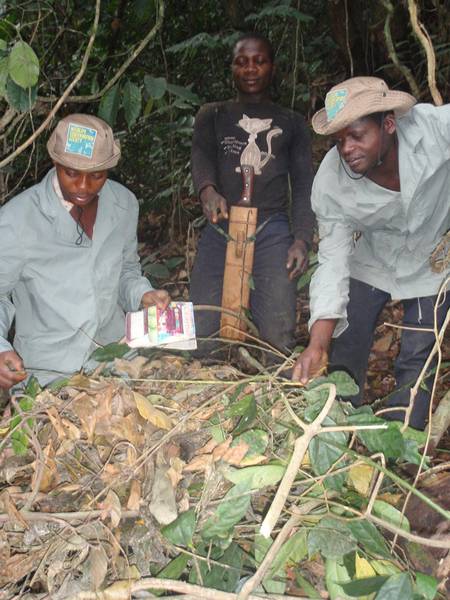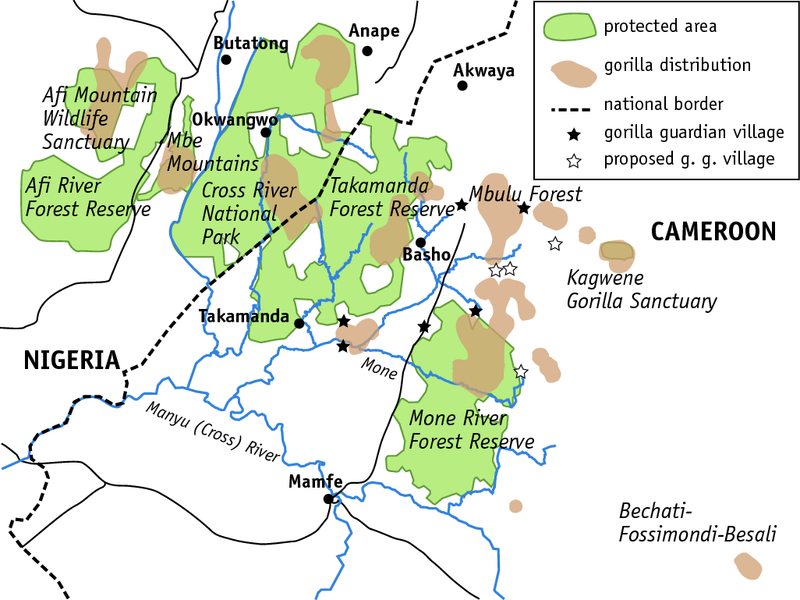Gorilla Guardians in Cameroon 2009
Categories: Journal no. 39, Threats, Protective Measures, Cameroon, Takamanda, Mone, Cross River Gorilla, Gorilla Journal
Faced with the challenge of improving the monitoring of unprotected Cross River gorilla sites in Cameroon, the Gorilla Guardian community-based monitoring network was established at the end of 2008 (<link internal-link>see Gorilla Journal 37). With a focus on the most vulnerable but important unprotected Cross River gorilla sites, our initial planning basically consisted of identifying villages with traditional forest rights over these sites; working with traditional authorities to identify Gorilla Guardians from each of the 6 villages identified in this way, and then building the capacity and understanding of the 6 selected Guardians in relation to basic gorilla ecology, monitoring and national wildlife laws through training at the Kagwene Gorilla Sanctuary.
The Gorilla Guardians started monitoring their gorillas in the Mbulu forest, Mawambi Hills and northern Mone Forest Reserve in January 2009 and since then, 3 WCS-led monitoring trips have visited each of these areas to work with the Guardians and local hunters to review the information that has been collected.
Two of the key initial expectations for the community-based Gorilla Guardian network were that 1) more regular basic monitoring data (status and distribution) would be generated in a more cost-effective manner and 2) the Guardians should act as informants in relation to threats to gorillas in each site. A further expectation is that over time, as the role of the Guardians becomes increasingly accepted within their communities, improved protection of their gorillas would also be achieved. I am happy to report that progress has been made in relation to both of these expectations.
Historically, our monitoring of gorilla presence in sites like the Mawambi Hills, northern Mone and the Mbulu forest has been restricted to periodic recce-style surveys. Organised remotely and at significant cost, these forest were only visited by trained field teams a few times in the last decade, normally with a number of years between visits. For example, the Mawambi Hills (just south of Takamanda National Park) were surveyed by Groves in 2001, Bergl in 2003 and Ekinde and Warren in 2007 and in total, data from 33 nest sites were collected during these visits. Thanks to the work of Gorilla Guardians Ferdinand Eyong and Simon Essa Ncha from Awuri and Takpe villages adjacent to the Mawambi Hills, working in collaboration with local hunters, 42 nest sites with a total of 269 nests were located and visited by WCS monitoring teams from the first 8 months of Gorilla Guardian monitoring alone. Records from the other two Gorilla Guardian sites for the same period follow a similar positive pattern with 34 nest sites having been located in northern Mone Forest Reserve (previous database total was 41 nest sites) and 43 nest sites in the Mbulu forest (previous database total was 48 nest sites).
The fact that Gorilla Guardians are helping generate significantly more nest site location data is important because it is helping further define the areas being used by Cross River gorillas at these different unprotected sites. This has implications in terms of improving our ecological understanding of Cross River gorilla distribution over time and space, may provide an improved picture of connectivity between different sites and will also help us plan further conservation action, including protection of the gorillas in these areas.
We have also achieved some progress in relation to our second expectation related to gaining a better understanding of the threats faced by gorillas at different unprotected sites. We have often promoted the fact that the hunting of Cross River gorillas has not taken place in recent years as a result of increased community sensitization and greater conservation presence in sites like Kagwene and Takamanda. But, reports from Gorilla Guardians now confirm that such statements may not be entirely accurate and that a small number of gorillas are still being killed by poachers in unprotected sites in Cameroon. A good example of this was the report received from one Guardian that a gorilla had been recently killed in the northern part of Mone Forest Reserve. Further investigations revealed that this was indeed the case and that a male gorilla (undetermined age) was shot in November 2008 by a local hunter. Although an investigation team was unable to secure the physical evidence needed to secure the effective prosecution of the alleged hunter, this has focused our attention on a number of villages that may still be actively involved in gorilla hunting. If not for the Guardian network, it seems less likely that this information would have reached us.
In subsequent issues, we hope to share more about the evolution of the Gorilla Guardian network. Thanks must be extended to the Margot Marsh Biodiversity Foundation and US Fish and Wildlife Service for their support to this programme.
Aaron Nicholas


